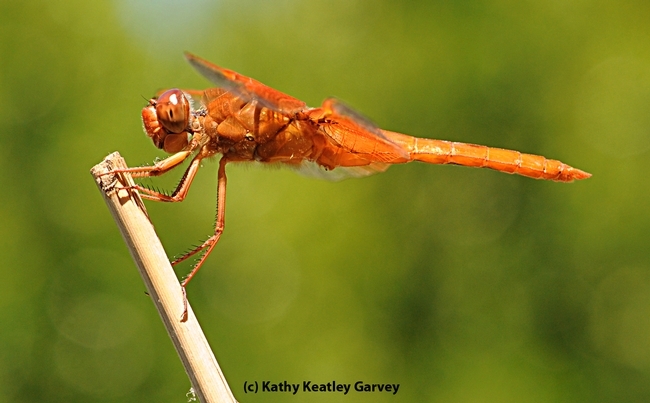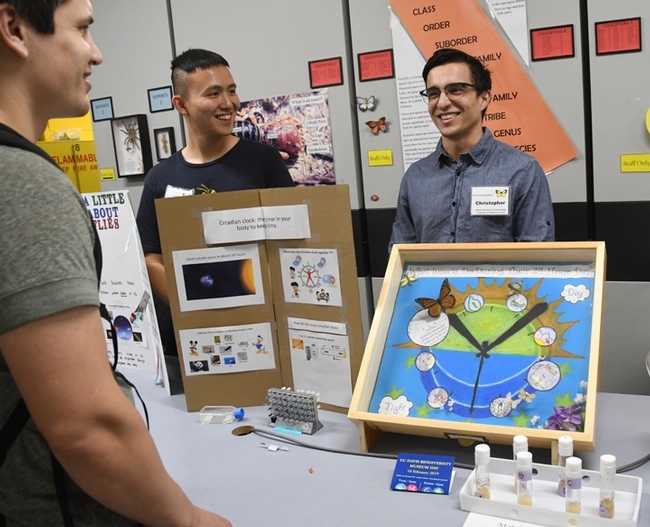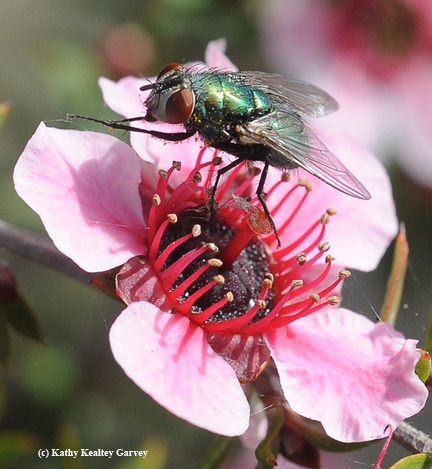- Author: Kathy Keatley Garvey
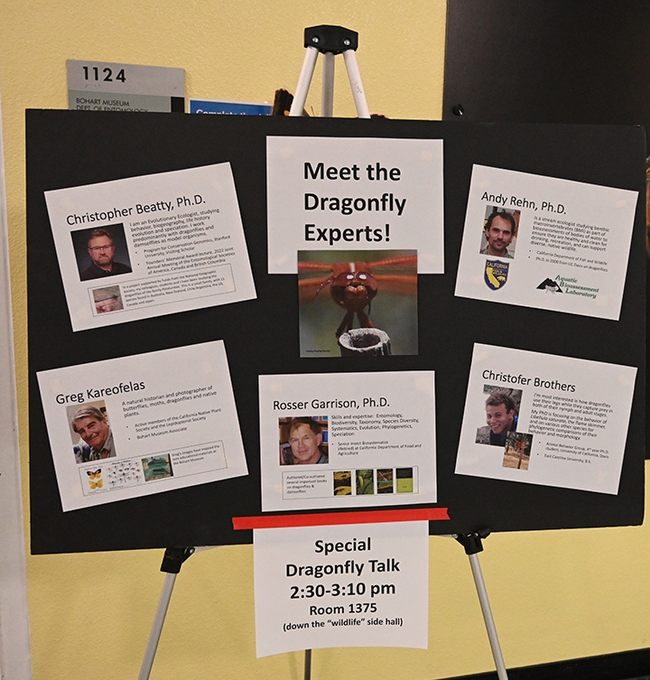
That was the theme of the Bohart Museum of Entomology open house on Sunday afternoon, Nov. 6, and dragonflies do just that--they rule.
They don't just rule in the water as larvae and in the air as adults.
They ruled at the Bohart Museum open house as visitors examined the displayed specimens; admired the images in the displayed books and the slide presentations; and chatted with the dragonfly experts.
A sign, "Meet the Dragonfly Experts," greeted the more than 220 guests:
- Rosser Garrison, retired from the California Department of Food and Agriculture (Pest Diagnostics Branch of Plant Health and Pest Prevention Services)
- Christopher Beatty, a visiting scholar in the Program for Conservation Genomics at Stanford University
- Bohart associate Greg Kareofelas
- UC Davis doctoral student Christofer Brothers of the laboratory of Professor and Chancellor's Fellow Stacey Combes, Department of Neurobiology, Physiology and Behavior, College of Biological Sciences.
- Andy Rehn, stream ecologist with the California Department of Fish and Wildlife and a UC Davis doctoral alumnus
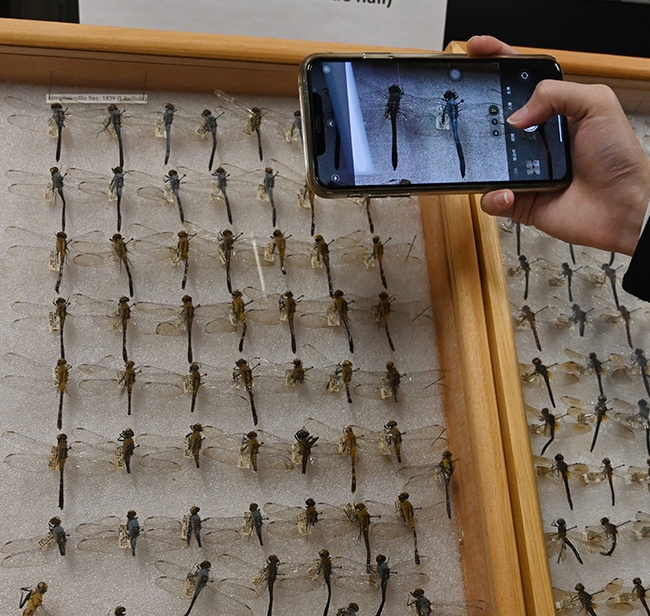
Garrison, widely recognized as one of the current leading experts of the taxonomy of New World Odonata, delivered an hour-long presentation and answered questions. He and his wife, Natalia von Ellenrieder, a senior insect biosystematist with CDFA, have worked intensively with the Odonata fauna of the Neotropical region. He has written more than 100 publications pertaining to Odonata, including three books: Dragonfly Genera of the New World: An Illustrated and Annotated Key to the Anisoptera (2006), Damselfly Genera of the New World: An Illustrated and Annotated Key to the Zygoptera (2010) and, as co-author, Dragonflies of the Yuangas: A Field Guide to the Species from Argentina (2007).
Garrison told the crowd that "There are over 6300 species of dragonflies throughout the world. They are excellent fliers; they hunt by sight and seize their prey (other insects) on the wing. Their size ranges between 2 and 15 centimeters."
Other facts discussed about dragonflies included:
- The larvae are aquatic and they can be carnivores.
- The fossil record is rich.
- Dragonfly relatives existed before the onset of the dinosaurs---Triassic Period, 250 to 200 million years ago
- They have a primitive flight mechanism compared to other insects, bees, butterflies, beetles and flies.
- Dragonflies mostly mate on the wing.
- They are not poisonous and they do not sew up people's ears (“devil's darning needles”). However, one group of large dragonflies are called—appropriately—"Darners."
- Larvae have a prehensile foldable lower lip unique in insects; it is used for capturing prey like mosquito larvae or even small fish.
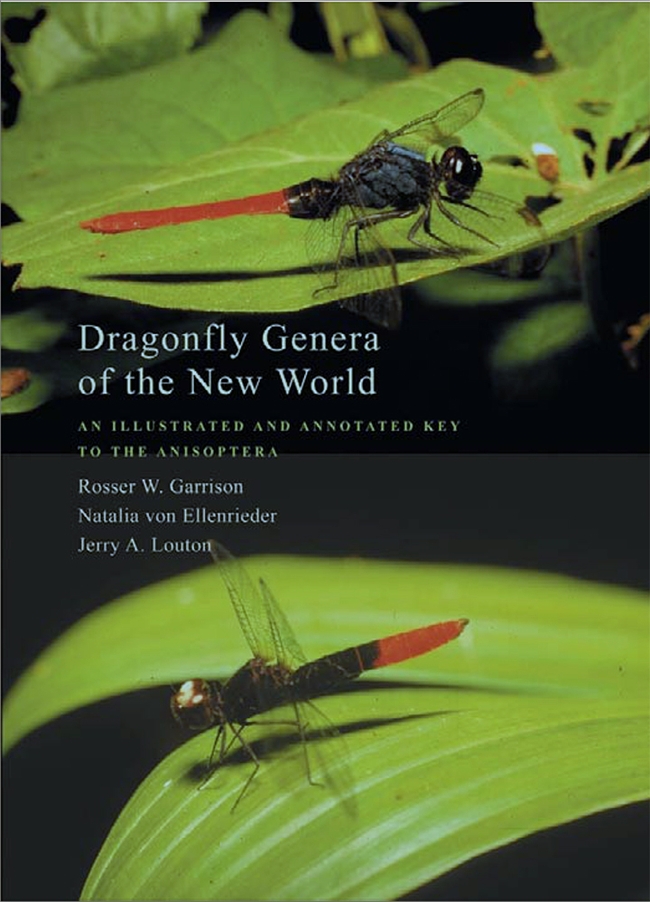
Garrison's publications include descriptions of more than 75 new species and six new genera of Odonata. In the Americas, he has done entomological field work in the United States, Mexico, Costa Rica, Panama, Guyana, French Guiana, Venezuela, Ecuador, Peru, Brazil, Argentina and Chile. He has also collected dragonflies in Australia, Papua New Guinea, China, Thailand, Namibia and Iran. One genus and 10 species of Odonates are named after him.
Christopher Beatty
Christopher Beatty has been working "for a few years on petaltail dragonflies, with much of the work focused on the Black Petaltail (Tanypteryx hageni) in California and Oregon." Beatty was recently selected to present the prestigious Entomological Society of America's Founders' Memorial Lecture at the 2022 Joint Annual Meeting of the Entomological Societies of America, Canada, and British Columbia. He'll speak at the awards breakfast on Nov. 15 on "The Passionate Observer: The Life and Times of Jean-Henri Fabre." Fabre (1823-1915) was a French naturalist, entomologist, educator, and author.
Beatty said he has focused much of his entomological career studying the behavior and ecology of dragonflies and damselflies, having served in research and teaching positions at the University of Vigo (Spain), Santa Clara University, Cornell University, the University of Kiel (Germany), and Stanford University. He has authored or co-authored more than 25 peer-reviewed articles since 2003, and he is co-editor of the newly published Dragonflies & Damselflies: Model Organisms for Ecological and Evolutionary Research, 2nd Edition (Oxford University Press).
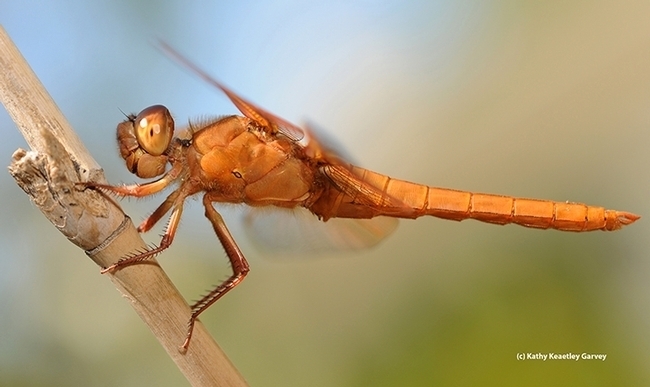
Andy Rehn is a stream ecologist studying benthic macroinvertebrates as part of bioassessments of bodies of water to ensure they are healthy and clean for drinking and recreation and can support diverse, native wildlife. He received his doctorate, studying dragonflies, at UC Davis in 2000.
Christofer Brothers
Cristofer Brothers is a fourth-year animal behavior doctoral student. He is researching how dragonflies, in both their nymph and adult stages, use their legs to capture prey. In particular, he studies the behavior of the flameskimmer, Libellula saturata. Brothers delivered a guest presentation on dragonfly predation behavior at the 2022 UC Davis Bio Boot Camp.
Greg Kareofelas
Greg Kareofelas credits Andy Rehn with inspiring him to study dragonflies. "That was when Andy was a doctoral student at UC Davis." Kareofelas, a longtime Bohart associate, naturalist and insect photographer, assists at Bohart events and presents informational talks at the Bohart Museum lab meetings, among other venues. He most recently gave a presentation on dragonflies at the Nov. 4th lab meeting. His work includes providing images for the poster, "Dragonflies of California," available in the Bohart Museum gift shop. Entomologist Fran Keller, a professor at Folsom Lake College and a UC Davis doctoral alumnus, designed the poster.
The Bohart Museum, founded in 1946, is located in Room 1124 of the Academic Surge Building, 455 Crocker Lane, UC Davis campus. Directed by Lynn Kimsey, UC Davis distinguished professor of entomology, it is the global home of eight million insect specimens, as well as the live "petting zoo" and an insect-themed gift shop stocked with t-shirts, hoodies, books, posters, jewelry, collecting equipment and more. Named for UC Davis professor and noted entomologist Richard Bohart, it is open to the public from 8 a.m. to noon, and 1 to 5 p.m., Mondays through Thursdays.
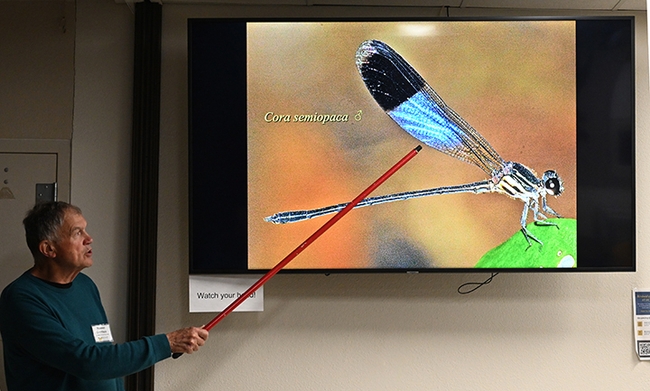
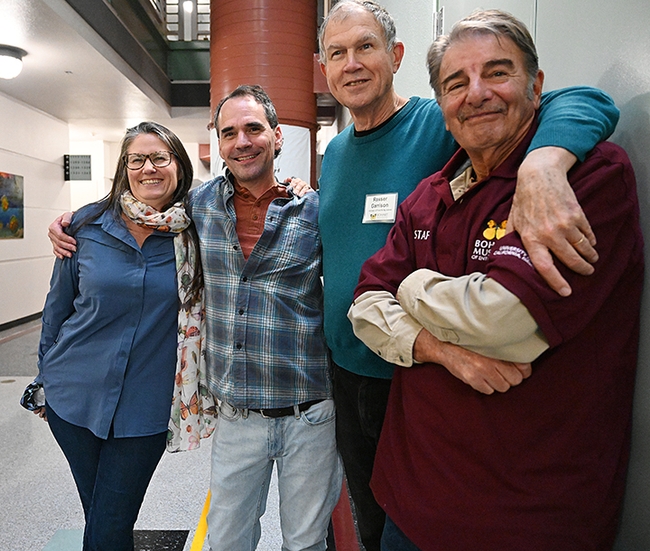
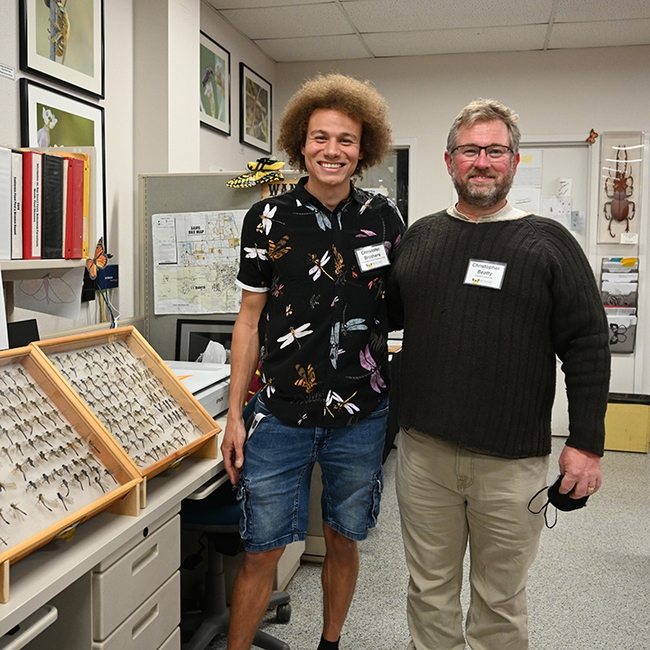
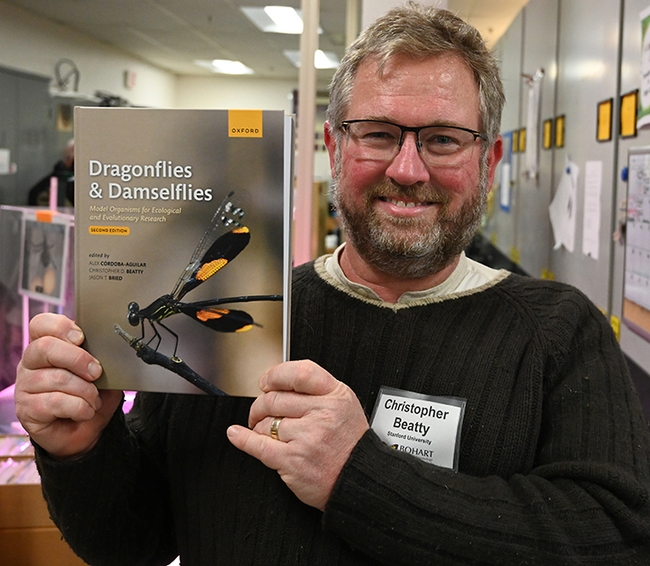
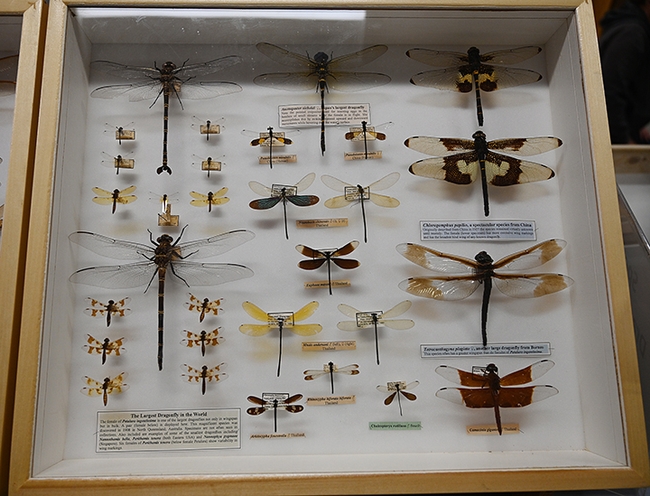
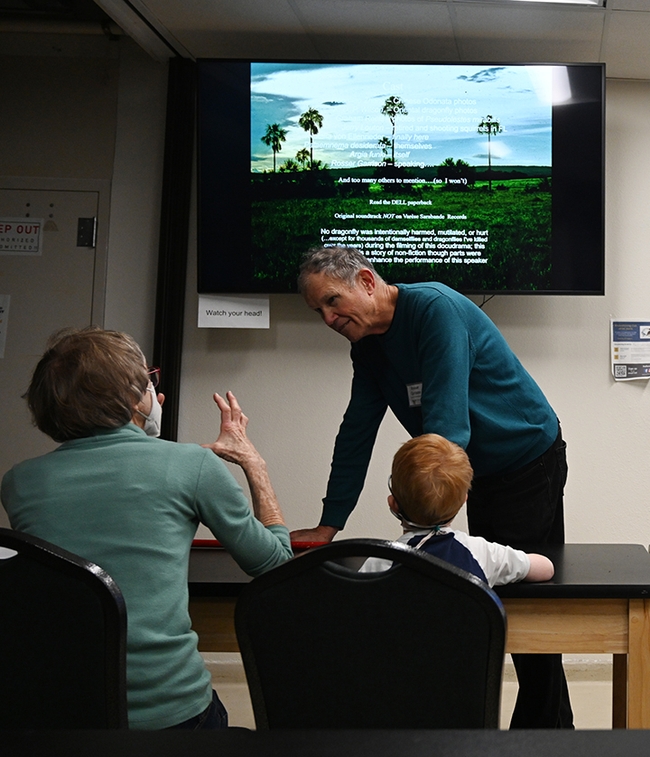
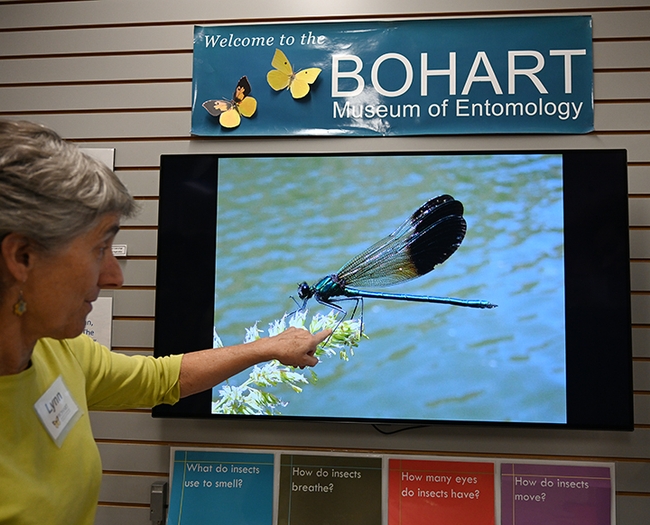
- Author: Kathy Keatley Garvey
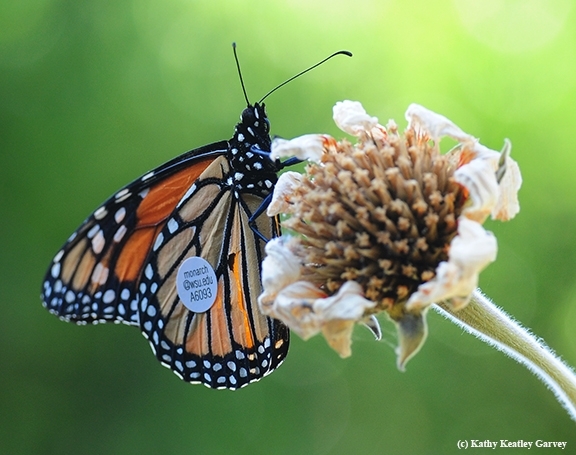
Take the case of a male monarch reared, released and tagged by Steven Johnson in a Washington State University citizen-science project operated by WSU entomologist David James. Johnson tagged and released the monarch on Sunday, Aug. 28, 2016 in Ashland, Ore. Seven days later, on Sept. 5, it fluttered into our family's backyard pollinator garden in Vacaville, Calif., where we photographed it.
"So, assuming it didn't travel much on the day you saw it, it flew 285 miles in 7 days or about 40.7 miles per day," James said. "Pretty amazing." (See Bug Squad blog)
But how do monarchs know when to migrate? You can find out when you attend the UC Davis Bohart Museum of Entomology open house on Saturday, Jan. 18 from 1 to 4 p.m. in Room 1124 of the Academic Surge Building, Crocker Lane.
Doctoral student Yao Cai, a fourth-year doctoral student in the Joanna Chiu lab who studies circadian clocks in insects, will relate how monarchs know when to migrate. “Using Drosophila melanogaster (fruit fly) and Danaus plexippus (monarch butterfly), as models, we seek to understand how these insects receive environmental time cues and tell time, how they organize their daily rhythms in physiology and behavior, such as feeding, sleep and migration (in monarch butterfly)," he says.
Cai is one of six doctoral students who will be showcasing their research. The event is free and family friendly.
Visitors not only will have the opportunity to talk to graduate students about their research and glean information about insects, but will be able see their work through a microscope. In fact, eight microscopes will be set up, Yang said.
In addition to Cai, doctoral students participating and their topics:
Ants: Zachary Griebenow of the Phil Ward lab, UC Davis Department of Entomology and Nematology
Assassin flies: Charlotte Herbert Alberts, who studies with major professor Lynn Kimsey, director of the Bohart Museum, UC Davis Department of Entomology and Nematology
Bats (what insects they eat): Ecologist Ann Holmes of the Graduate Group in Ecology, Department of Animal Science, and the Genomic Variation Laboratory, who studies with major professors Andrea Schreier and Mandi Finger.
Bark Beetles: Crystal Homicz. who studies with Joanna Chiu, UC Davis Department of Entomology and Nematology and research forest entomologist Chris Fettig, Pacific Southwest Research Station, USDA Forest Service, Davis.
Forensic entomology: Alexander Dedmon, who studies with Robert Kimsey, UC Davis Department of Entomology and Nematology
Some doctoral students also will deliver PowerPoint presentations or show slides. The projects:
Bark Beetles
“Did you know that between 1987 and 2017 bark beetles were responsible for more tree death than wildfire?” asks Crystal Homicz, a first-year doctoral student. “Bark beetles are an incredibly important feature of forests, especially as disturbance agents. My research focuses on how bark beetles and fire interact, given that these are the two most important disturbance agents of the Sierra Nevada. At my table, I will discuss how the interaction between bark beetles and fire, why bark beetles and fire are important feature of our forest ecosystem, and I will discuss more generally the importance of bark beetles in many forest systems throughout North America.
“I will have several wood samples, insect specimens and photographs to display what bark beetle damage looks like, and the landscape level effects bark beetles have. I will also have samples of wood damage caused by other wood boring beetles and insects. My table will focus widely on the subject of forest entomology and extend beyond beetle-fire interactions.”
Visitors, she said, can expect to leave with a clear understanding of what bark beetles are and what they do, as well as a deeper understanding of the importance of disturbance ecology in our temperate forests.
Assassin Flies
Charlotte Alberts, a fifth-year doctoral candidate, will display assassin flies and their relatives, as well as examples of prey they eat and/or mimic. Visitors can expect to learn about basic assassin fly ecology and evolution. Alberts studies the evolution of assassin flies (Diptera: Asilidae) and their relatives.
“Assassin flies are voracious predators on other insects and are able to overcome prey much larger than themselves,” she said. “Both adult and larval assassin flies are venomous. Their venom consists of neurotoxins that paralyze their prey, and digestive enzymes that allow assassin flies to consume their prey in a liquid form. These flies are incredibly diverse, ranging in size from 5-60mm, and can be found all over the world! With over 7,500 species, Asilidae is the third most specious family of flies. Despite assassin flies being very common, most people do not even know of their existence. This may be due to their impressive ability to mimic other insects, mainly wasps, and bees.”
For her thesis, she is trying to resolve the phylogenetic relationships of Asiloidea (Asilidae and their relatives) using Ultra Conserved Elements (UCEs), and morphology. "I am also interested in evolutionary trends of prey specificity within Asilidae, which may be one of the major driving forces leading to this family's diversity."
Bats
Ecologist Ann Holmes, a fourth-year doctoral student, is studying what insects that bats eat. "I will be talking about my research project that looks at insects eaten by bats in the Yolo Bypass. The insects eat crops such as rice, so bats provide a valuable service to farmers. Hungry bats can eat as much as their own body weight in insects each night."
"Visitors can expect to learn how DNA is used to detect insects in bat guano (poop)." "Insects in bat poop are hard to identify because they have been digested, but I can use DNA to determine which insects are there," she said. "We care about which insects bats eat because bats are natural pest controllers. With plenty of bats we can use less pesticide on farms and less mosquito repellent on ourselves."
Ants
Zachary Griebenow, a third-year doctoral student, will be showcasing or discussing specimens of the ant subfamily Leptanillinae, most of them male. “I will be showing specimens of the Leptanillinae under the microscope, emphasizing the great morphological diversity observed in males and talking about my systematic revision of the subfamily," he said. "In particular, I want to explain how the study of an extremely obscure group of ants can help us understand the process of evolution that has given rise to all organisms."
Forensic Entomology
Forensic entomologist Alex Dedmon, a sixth-year doctoral student, will display tools and text and explain what forensic entomology is all about. "My research focuses on insect succession. In forensic entomology, succession uses the patterns of insects that come and go from a body. These patterns help us estimate how long a person has been dead. Visitors can expect to learn about the many different ways insects can be used as evidence, and what that evidence tells us."
Other Open House Activities
The family craft activity will be painting rocks, which can be taken home or hidden around campus. "Hopefully some kind words on rocks found by random strangers can also make for a kinder better future,” said Yang.
In addition to meeting and chatting with the researchers, visitors can see insect specimens (including butterflies and moths), meet the critters in the live “petting zoo” (including Madagascar hissing cockroaches, walking sticks and tarantulas) and browse the gift shop, containing books, insect-themed t-shirts and sweatshirts, jewelry, insect-collecting equipment and insect-themed candy.
The Bohart Museum, directed by Professor Lynn Kimsey and founded by noted entomologist Richard M. Bohart (1913-2007), houses a global collection of nearly eight million specimens. It is also the home of the seventh largest insect collection in North America, and the California Insect Survey, a storehouse of insect biodiversity.
The insect museum is open to the public Mondays through Thursdays from 9 a.m. to noon and 1 to 5 p.m., except on holidays. More information on the Bohart Museum is available on the website at http://bohart.ucdavis.edu or by contacting (530) 752-0493 or bmuseum@ucdavis.edu.
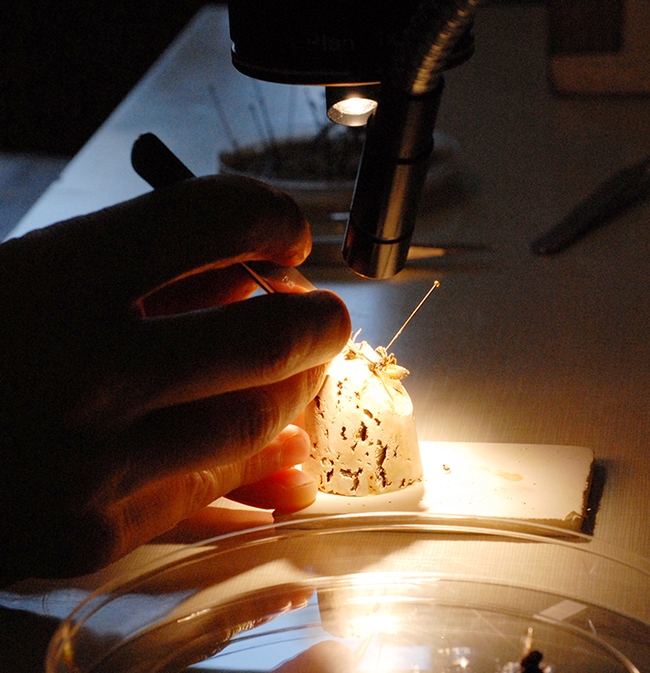
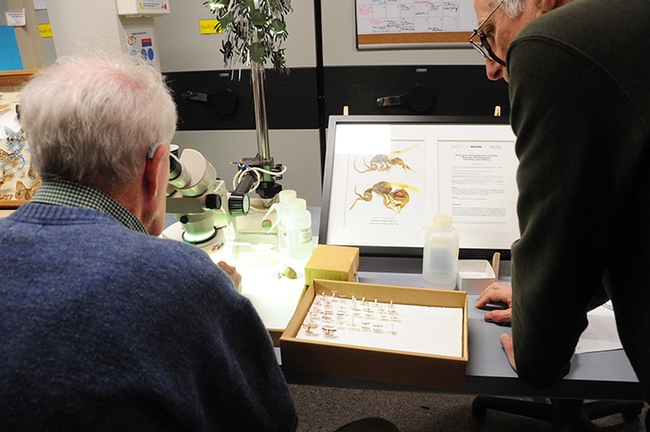
- Author: Kathy Keatley Garvey
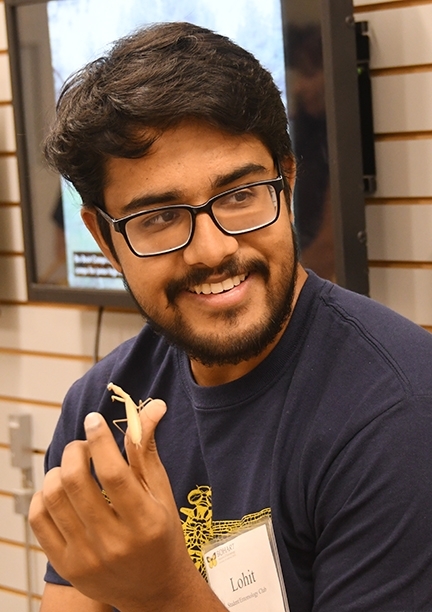
Scientists at the UC Davis Bohart Museum of Entomology will help you do just that.
They've scheduled an open house on “Arthropod Husbandry: Raising Insects for Research and Fun” from 1 to 4 p.m., Saturday, Nov. 16 in Room 1124 of the Academic Surge Building on Crocker Lane. It's free and family friendly.
"We will have a number of people who are expert at raising insects, both for research and for fun," said Tabatha Yang, Bohart Museum education and outreach coordinator. UC Davis student Andrew Goffinet, a former UC Davis Bio Boot Camper, will be on hand to talk about rearing butterflies and moths. UC Davis entomology alumnus Lohit Garikipati will discuss praying mantids.
Another entomology alumnus Nicole Tam, will talk about rearing insects in the Geoffrey Attardo lab as part of research projects. Doctoral student and Bohart associate Zaid Khouri's topic is how to rear tarantulas and millipedes for fun.
"We also will be discussing Madagascar hissing cockroaches (hissers) as good options for 'starter pets' for kids, and some of the problems with stick insects (walking sticks)," Yang said. Visitors are invited to hold the hissers and stick insects and photograph them.
At 3 p.m., silkworm moth expert İsmail Şeker, a Turkish medical doctor who wrote a book about silkworm moths and the cottage silk industry in his home town, will show his newly produced video about the silkworm moth life cycle. Seker, also a talented videographer and a photographer, will answer questions following his 13-minute video presentation.
"This will be a fun open house for anyone considering a pet with an exoskeleton," Yang said."It will be good for educators to learn about classroom 'pets,' including those who do work with silk moths for life cycle lesson plans."
"Also, to kick off the holiday season we will have the unique wire jewelry by former entomology major Ann Kao, so people should be prepared to shop for some unique insect-inspired jewelry."
A family craft activity is also planned. This is the last open house of the year. The next open house will be on Jan. 18 when UC Davis graduate students from many different fields "will be talking/displaying about their cutting edge research with insects," Yang said.
The Bohart Museum houses a global collection of nearly eight million specimens. It is also the home of the seventh largest insect collection in North America, and the California Insect Survey, a storehouse of the insect biodiversity. Noted entomologist Richard M. Bohart (1913-2007) founded the museum. It maintains a live "petting zoo," featuring Madagascar hissing cockroaches, walking sticks or stick insects and tarantulas. The museum's gift shop, open year around, is stocked with T-shirts, sweatshirts, books, jewelry, posters, insect-collecting equipment and insect-themed candy.
Director of the museum is Lynn Kimsey, professor of entomology at UC Davis. The staff includes Steve Heydon, senior museum scientist; Tabatha Yang, education and outreach coordinator; and Jeff Smith, who curates the Lepidoptera (butterflies and moths) section.
More information on the Bohart Museum is available on the website at http://bohart.ucdavis.edu or by contacting (530) 752-0493 or bmuseum@ucdavis.edu.
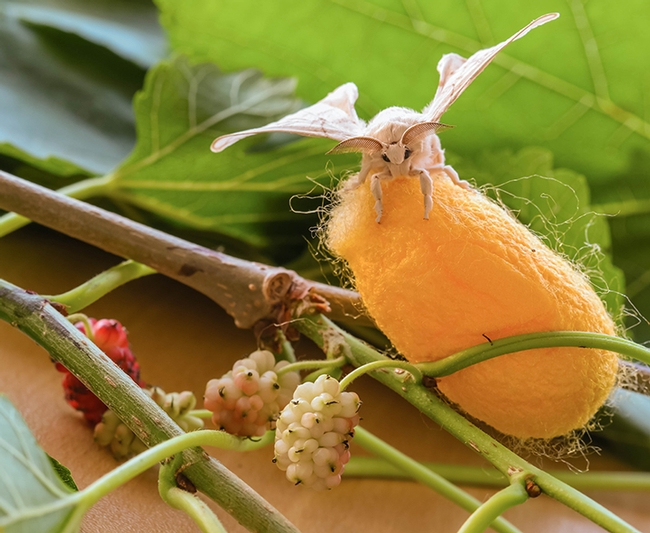
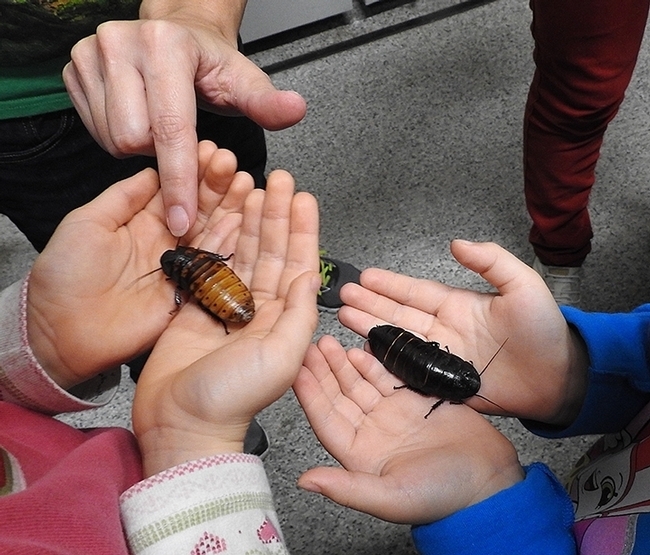
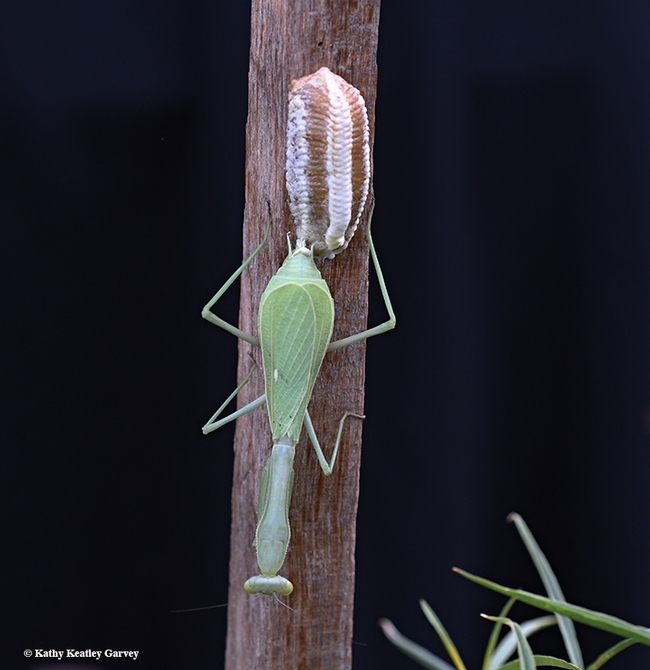
- Author: Kathy Keatley Garvey
That rhymes.
And that's what's planned as the family craft activity when the Bohart Museum of Entomology hosts an open house on fly research from 1 to 4 p.m., Saturday, Jan. 12 in Room 1124 of the Academic Surge Building, located on Crocker Lane, UC Davis campus. It's free and family friendly.
Bohart associate and entomology undergraduate student Wade Spencer has ordered the maggots. The tables are set up and ready.
All you do is pick up a maggot, dip it into a non-toxic, water-based paint, and let it crawl--or guide it--on a piece of paper. Voila! Art. Maggot art. And perfect for framing or posting on your refrigerator or bulletin board.
It's a conservation piece.
"Umm, what's that on your refrigerator?"
"Maggot art."
"Wh-a-a-t?"
And so the story begins.
If you've ever been to the annual UC Davis Picnic Day (this year's it's April 13) and wandered over to Briggs Hall, home of the UC Davis Department of Entomology and Nematology, you'll see Maggot Art in action. t's known as one of the most popular Picnic Day activities.
Several years ago we asked forensic entomologist Robert Kimsey of the UC Davis Department of Entomology and Nematology faculty (and a past president of the North American Forensic Entomology Association) for his take on Maggot Art.
One of his former graduate students, Rebecca O'Flaherty, coined the term and the activity back in 2001 when she was studying at the University of Hawaii. She was rearing blowflies for her forensic research and wanted an activity to draw the interest of elementary school students in her teaching program. She sought to generate interest and respect for an entomological wonder that's more associated with road kills and goose bumps than art thrills.
Her Maggot Art activity drew national interest. "The beauty of the Maggot Art program," she told me, "is its ability to give hands-on, non- experiences with an insect that most people fear or loathe."
So what was Professor Kimsey's take on it ?
"This is an extremely interesting and innovative idea that combines vry basic biology with art in a form that people can readily access and understand," he said. "It provides an entrée into the biology and development of insects that people can really appreciate and understand. It was a stroke of genius."
What the Bohart folks do is also a stroke of genius.

- Forensic entomologists Danielle Wishon, graduate of UC Davis, and doctoral student Alex Dedmon of the Robert Kimsey lab
- Fourth-year doctoral student Charlotte Herbert Alberts of the Lynn Kimsey lab, Bohart Museum, who studies assassin flies
- Graduate student Socrates Letana of the Lynn Kimsey lab, Bohart Museum, who studies botflies
- Doctoral student Caroline Wright Larsen of the James R. Carey lab, who studies non-native non-native tephritid flies, including Mediterranean fruit flies
- Graduate students Christine Tabuloc and Yao Cai and undergraduate students Cindy Truong and Christopher Ochoa, all of the Joanna Chiu lab, who research fruit flies
- Nermeen Raffat, a visiting scholar in the Sharon Lawler lab, who studies "the effect of copper sulphate and other toxicants on the development and anti-predatory behavior of the mosquitoes larvae."
Undergraduate student Kathlyne-Inez Soukhaseum of the Frank Zalom lab, who researches the fruit fly, the spotted-wing drosophila, Drosophila suzukii, was initially scheduled to participate.
Dedmon is the newest addition to the list of those who will be participating at the Bohart open house. Working with major professor Robert Kimsey, he studies forensic entomology--the use of insects as evidence in the court of law. "My work is in insect succession, or the composition and patterns of insects that come to and from a decedent," he related. "I am interested in defining these patterns, as well as the various factors that influence them. Specifically, I seek to make insect succession a more reliable tool in evaluating the postmortem interval of a decedent, that is, the time elapsed since death. Ultimately, the goal of my research is to provide a stronger foundation of evidence for forensic entomologists testifying in court."
Besides checking out the flies--and creating maggot art--this is also a good time for visitors to inquire about graduate school, ask about starting research projects, and to meet people working in forensics, evolution, agriculture, animal behavior, genetics, geography, and home pests, among other topics," said Tabatha Yang, education and outreach coordinator.
Entomologist Jeff Smith, who curates the Bohart's butterfly and moth section, will be on hand to open the Diptera section and answer questions.
"We've never had a fly specialist here at UC Davis except for mosquitoes," said Lynn Kimsey, director of the Bohart Museum and professor of entomology. "We have one of the world's largest mosquito collections. Overall, I'd guess we have 300,000 fly specimens."
The Bohart Museum houses nearly eight million insect specimens, a live "petting zoo" (think Madagascar hissing cockroaches, stick insects, tarantulas and praying mantids) and a year-around gift shop. The museum is open to the general public Mondays through Thursdays, from 9 a.m. to noon and from 1 to 5 p.m., plus occasional, weekend open houses. Admission is free. Further information is available on the Bohart Museum website at http://bohart.ucdavis.edu/ or contact (530) 753-0493 or bmuseum@ucdavis.edu.
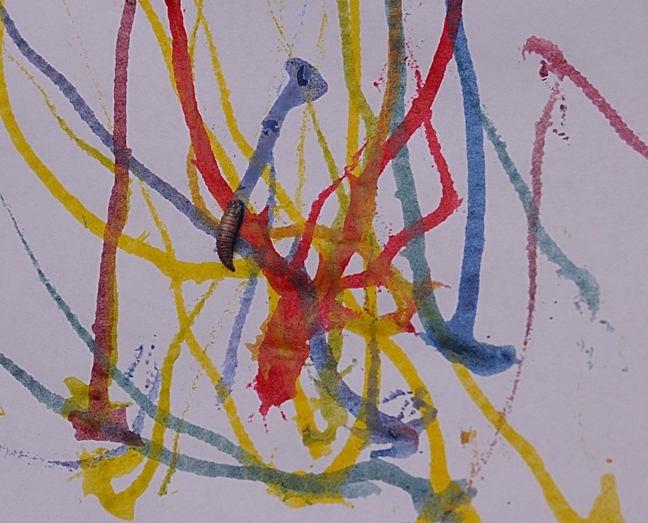
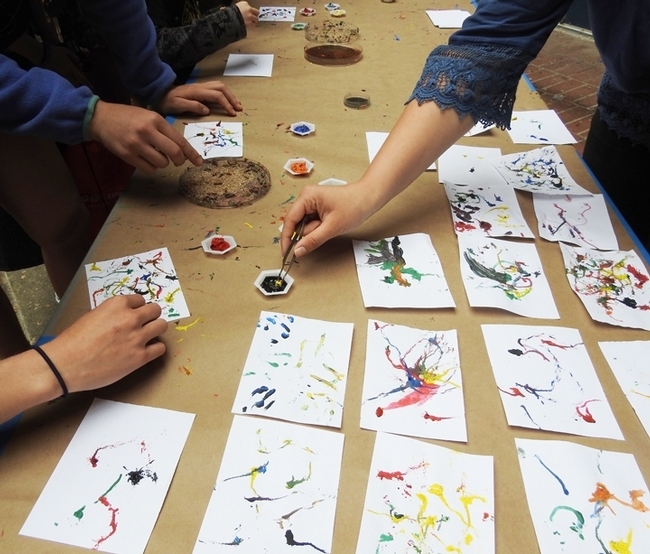
- Author: Kathy Keatley Garvey
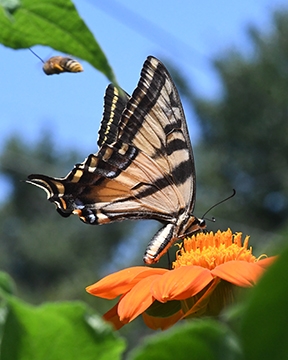
Sunday afternoon, Jan. 21 promises to be a day of inspiration, creativity and delight when the Bohart Museum of Entomology hosts an open house, "Bug-Art@The Bohart" from 1 to 4 p.m. in Room 1124 of the Academic Surge Building, Crocker Lane.
On the other side of campus, the Design Museum exhibition, It's Bugged: Insects' Role in Design will be open from 2 to 4 p.m. in Room 124 of Cruess Hall, off California Avenue.
At the Bohart, UC Davis undergradauate student and artist Karissa Merritt will be on-hand sketching insects for all to see, said Tabatha Yang, education and outreach coordinator. Other activities/focal points at the open house:
- Art display from the collection of the late Mary Foley Bensen, a former Smithsonian Institution scientific illustrator who lived the last years of her life in Davis, and who worked for entomology faculty
- Art display from Lynn Kimsey, director of the Bohart Museum and professor of entomology, who illustrated under her maiden name Lynn Siri
- Art display by Charlotte Herbert, Ph.D. student; and UC Davis alumnus Ivana Li and Nicole Tam, who hold degrees in entomology from UC Davis
- Exhibit of "insect wedding photography" by Bohart associates Greg Kareofelas and Kathy Keatley Garvey
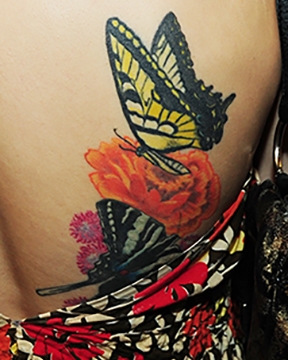
Open house attendees are invited to wear insect-themed attire, including dresses, ties, and jewelry. A contest will take place at 3 p.m. for the best insect-themed outfit, and for the best insect-themed tattoo (tattoo must be in a family friendly location).
Entomologist Jeff Smith, who curates the butterfly and moth collection at the Bohart and is newly returned from a collecting trip to Belize, will be on hand to show the Bohart collection.
At the Design Museum, among the work that visitors can view are the beetle gallery sculptures and hornet nest paper art of Ann Savageau, professor emeritus of the Department of Design; bee, butterfly and beetle specimens from the Bohart Museum; and images by UC Davis alumnus and noted insect photographer Alex Wild, curator of entomology at the University of Texas, Austin. Wild received his doctorate in entomology from UC Davis in 2005, studying with major professor Phil Ward.
The Bohart Museum houses a global collection of nearly eight million specimens. It is also the home of the seventh largest insect collection in North America, and the California Insect Survey, a storehouse of the insect biodiversity. Special attractions include a “live” petting zoo, featuring Madagascar hissing cockroaches, walking sticks, praying mantids and tarantulas. Visitors are invited to hold some of the arthropods and photograph them. The museum's gift shop, open year around, includes T-shirts, sweatshirts, books, jewelry, posters, insect-collecting equipment and insect-themed candy.
The Bohart Museum holds special open houses throughout the academic year. Its regular hours are from 9 a.m. to noon and 1 to 5 p.m. Mondays through Thursdays. The museum is closed to the public on Fridays, Saturdays and Sundays and on major holidays. Admission is free. More information on the Bohart Museum is available by contacting (530) 752-0493 or emailing bmuseum@ucdavis.edu or Tabatha Yang at tabyang@ucdavis.edu.
